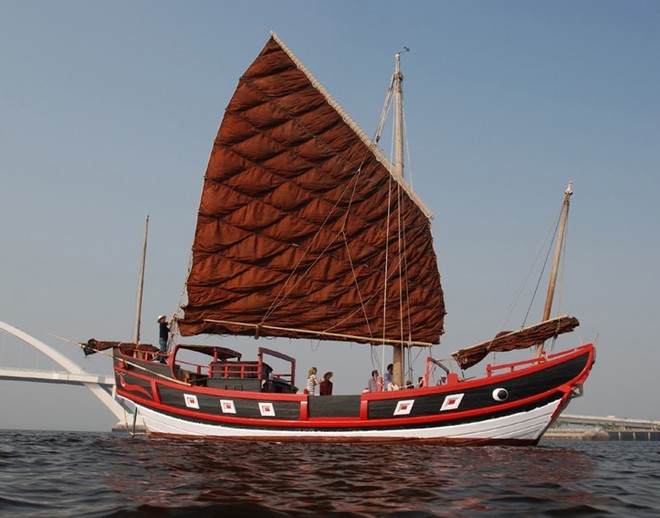Did the Chinese Sail to America before Columbus?
by Leonard Novarro/Sail-World Cruising on 4 Jan 2009

Faithfully built to original design SW
It’s a theory. Now, someone is more than half way to proving that it probably happened. The Chinese Junk, the Tai Ping, manufactured and sailed as Chinese Junks were 600 years ago, has arrived in Hawaii half way across the Pacific on its return journey.
The Tai Ping arrived at the Ala Wai Small Boat Harbor in Honolulu in late December and is scheduled to leave in early February. There is one American on board, Hugh Morrow.
In April, Capt. Nelson Liu and a crew of eight left from Hong Kong and Taiwan to sail across the Pacific in exactly the same vessel used by Chinese sailors more than 600 years ago. In fact, the Princess TaiPing that sailed into San Diego Harbor on Nov. 16, after stops in Vancouver, Canada; Seattle and San Francisco, was many times smaller than the historic Chinese junks that sailed the seas when China was at the zenith of its maritime power.
Given the historical fact that 10 anchors from similar Chinese ships have been found in the bottom of the ocean in various parts of the West Coast – and the theory becomes more than conjecture.
The TaiPing, launched last January after six years of research and development, sailed from Taiwan to Okinawa and Japan, crossed 5,100 miles of ocean to Northern California, then sailed down to San Diego before coming to Hawaii.
Liu, 61, said the crossing from Japan to Eureka, Calif., took 69 days, with sea swells sometimes in excess of 15 feet and crew members sleeping in tiny crawl spaces covered by a row of hatches down the center of the boat.
'I did something to prove our ancestors could do such a voyage,' said Liu, a congenial, soft-spoken man in his 50s, during an interview before sailing back to China. 'If we could do it, our ancestors could have done it,' added Liu.
Everything he and his crew did was exactly as it might have been 600 years ago. They washed and did dishes with sea water – even brushed their teeth. And they ate what they caught along the way – mostly squid and mahi mahi. Tea was also prepared every day in the ancient way. And living quarters? Barely wide enough to house a duffle bag, but they managed.
Of course, there were concerns such as pirates and storms, but Liu is a man of experience who sailed around the world several times, although in modern, Western-type sailing vessels. In 1992, he crossed the Pacific 'in the wrong season. We hit a typhoon,' he explained. 'But, on the other hand, the boat was tested. It sailed wonderfully, but I was scared to death.'
The experience also tested Liu and convinced him that the voyage of a lifetime could be done, so he set out to raise funds to make a longtime dream come true.
Just as the revival of the hokulea, or outrigger canoe, inspired Polynesians some 30 years ago, Liu wanted to bring the same pride to Chinese culture.
'Our mission is to restore the craftsmanship and navigation techniques of ancient Chinese people, to honor the richness of Chinese maritime culture, and to applaud the glorious pieces in Chinese history,' Liu wrote in a promotional piece published by National Geographic magazine.
Eighty-seven years before Christopher Columbus made his famous voyage, China’s most famous navigator, Zheng He (Cheng Ho), was sailing throughout the South Pacific and Indian Ocean, recording seven epic voyages to the Persian Gulf and faraway Africa. Zheng’s flagship was 400 feet long, much larger than the Princess TaiPing, as well as Columbus’ Santa Maria. From the beginning of the 15th century, and for 28 years, he traveled some 60,000 miles, visiting more than 30 countries.
Liu set out to revive this tradition, which included building a replica of a Chinese junk from scratch and with the same materials used centuries ago, relying on records and documents from the Ming Dynasty to maintain accuracy. Not only is the appearance the same; so were the shipbuilding techniques, which meant no bolts, screws or anything synthetic.
While similar craft have been built using fiberglass and other synthetic materials, the Princess TaiPing is all wood.
Construction was finally completed last year and a trial run made from Hong Kong to Taiwan before setting sail across the Pacific in January of this year. After being docked at the San Diego Maritime Museum for two weeks, the ship embarked on its return voyage Saturday, Nov. 29.
There were those, of course, who told him that it couldn’t be done. And those who simply called him 'nuts.'
What kept him going through all the negativity? 'Simply passion,' he said, as well as proving that in this era of globalization and conformity, 'our old traditions are not so bad.'
All the time, his message was this: Stay constant. Don’t be discouraged. And, most of all, don’t be afraid to try something new.
Even if it means going against the tide.
If you want to link to this article then please use this URL: www.sail-world.com/52464